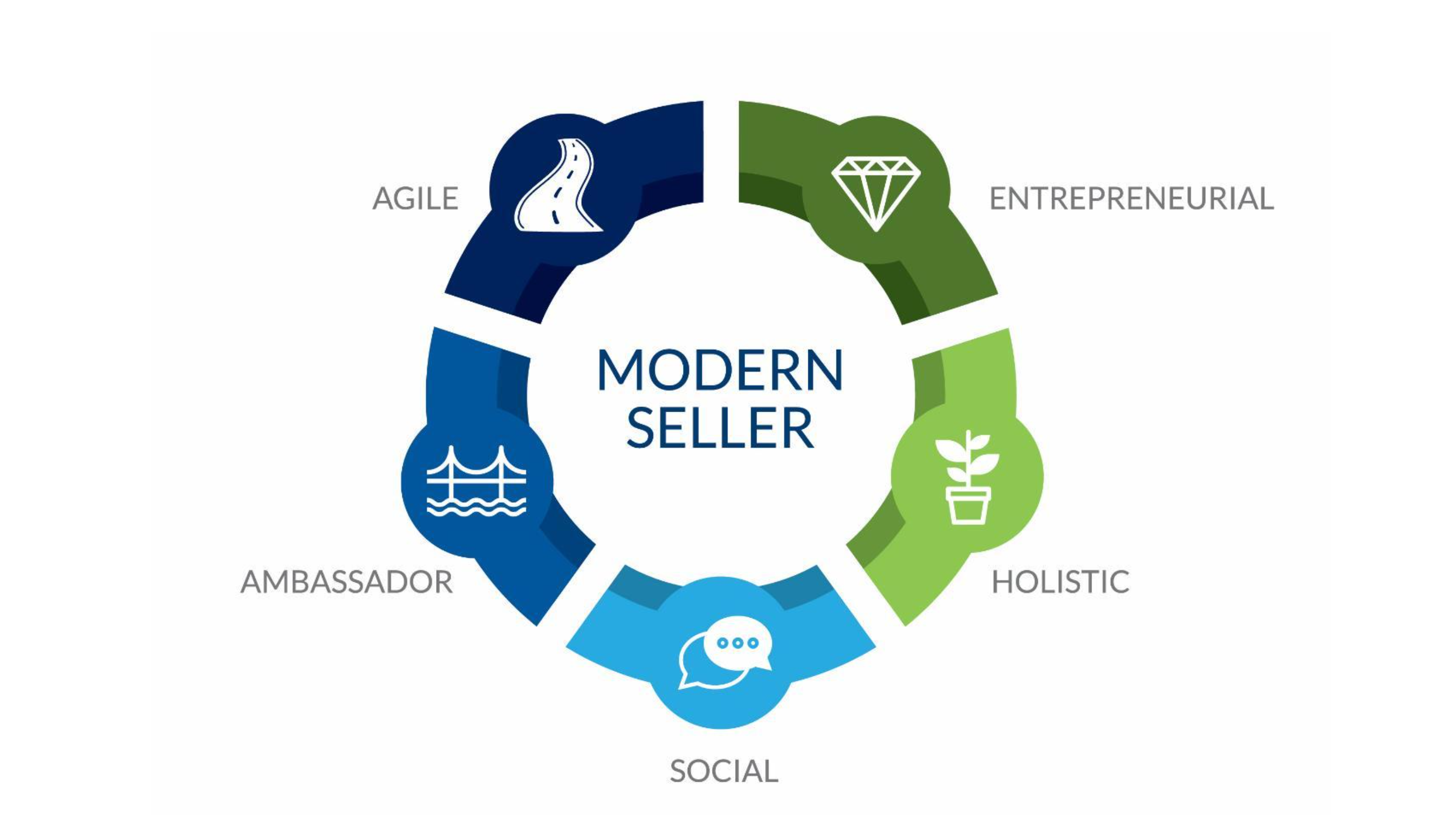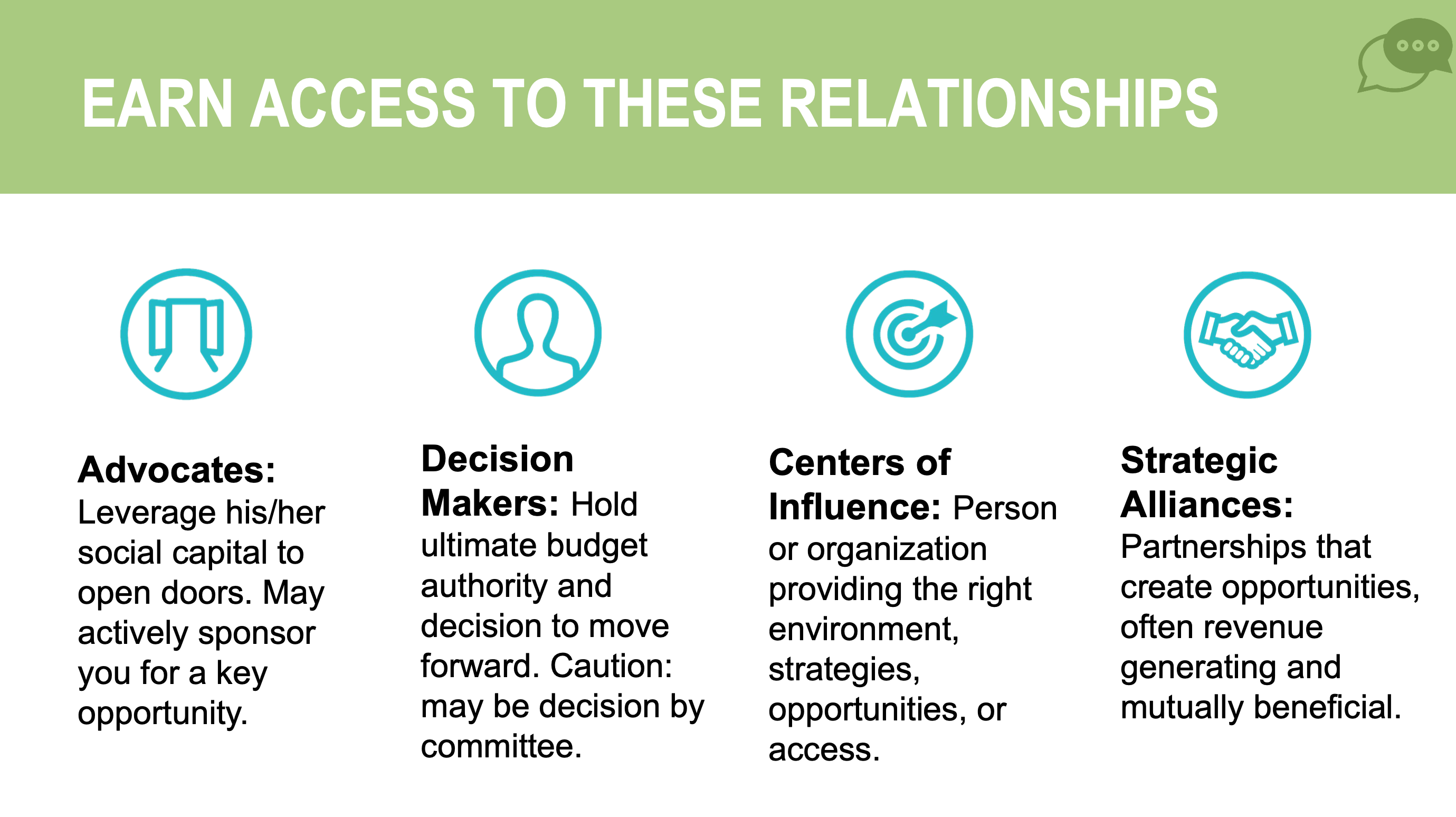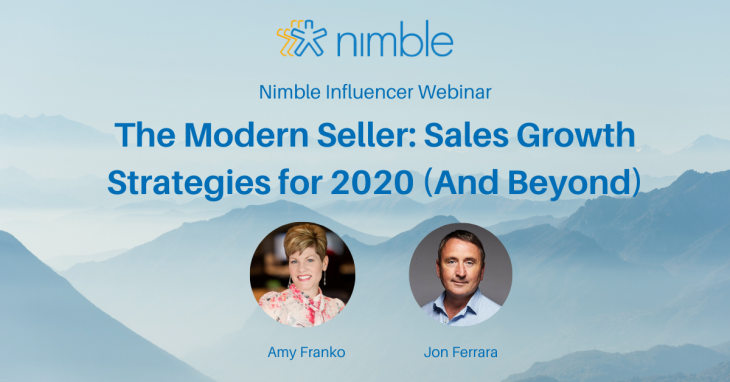If you missed our webinar with sales strategist and keynote speaker Amy Franko, no worries – we’ve got you covered with our Nimble Influencer Webinar Replay. In this webinar, Nimble CEO Jon Ferrara and Amy Franko discuss concepts from Amy’s book, The Modern Seller.
Amy is inspired to educate B2B sales and sales leadership development to businesses in order to achieve their goals. Her book, The Modern Seller, is an Amazon bestseller and was also named a 2019 top sales book by Top Sales World. She is recognized by Top Sales World as one of the tops 50 sales bloggers in the world. Now, get your leadership hats on, and let’s learn what it takes to be a modern seller!
3 Major Trends in the Modern Sales World
World of sameness
In the eyes of a prospect or client, you can be seen as the same as everyone else. The problem with organizations is that they focus on themselves rather than on the prospects or client’s challenges and opportunities, which can lead organizations to seem the same. If everyone looks the same, prospects and clients start to look at the price as their primary differentiator.
“To combat this world of sameness, we have to continually look for ways to be different in the eyes of our prospector and clients”, Amy says.
Accelerated ROI
Amy was in a sales meeting with a local president and chief sales officer discussing different sales training solutions, but the local president had a new priority. She asked Amy a question about how to make it happen as soon as possible. However, she wasn’t prepared for the question. After this meeting, Amy learned that most prospects and clients are racing from priority to the next, but priorities can switch. Prospects and clients have become a lot more sophisticated in terms of return on investment because they are under pressure to deliver results to their business.
You could help your prospects and clients focus on short-term goals and accomplish the two or three most valuable returns on investment points by working together and understanding each other’s objectives.
One tactic that you could put into your sales activities is by looking for the annual reports or any presentation delivered by a CEO or executive in the organization. You can uncover what their key goals are for the year. Use those goals to drive a conversation with the prospect or client to understand how it affects them and what they want to accomplish in the business. You’ll start to piece together an ROI version that is crystal clear on the two or three most important goals.
Decision by committee
The decision by committee trend is being aware of who’s involved in the decision-making process and who might be the ear of the decision-makers’ information.
So many people have relationship gaps. The problem with relationship gaps is that it increases the risk of somebody potentially influencing a decision-maker or set of decision-makers without you knowing before it’s too late.
Amy talks about her personal experience when she fell into the decision by committee trap. She ended up losing a massive opportunity because she wasn’t aware of some of the relationships that were involved in the decision-making process. What she took away from this painful experience was the more awareness built around who is involved in the decision-making process and then seeing where the relationship gaps are, the better the odds you have of closing those gaps and earning those opportunities.
Amy noticed the importance of talking about the skills behind the skills that can make us better as sellers and business leaders, which catalyzes her to create The Modern Seller and these five dimensions.

Agile
Agility is one of the top-five skills organizations are looking to hire for and to develop. The good thing is that this skill can be built. Agility is being able to be comfortable during uncomfortable situations and have a very high figured out factor. Someone agile is excellent at being able to filter and process lots of information and curate out what’s most important- especially in sales situations.
Agility allows prospects and clients to rely on them for fresh and new ideas for their business. If you build agility in yourselves, you can ultimately help not only the business to thrive, but your prospects and customers to thrive as well.
One strategy Amy suggests is pattern switching. Pattern switching is creating a new routine and a new environment. Analyzing your selling patterns is a way of practicing pattern switching. For example, Amy noticed she was in a prospecting rut: not getting the results and procrastinating. To combat her problem, she analyzed what she was doing, inserted a new routine, and changed her environment.
She began going into a different office environment, which forced her to change her routine. This pattern switching allowed her to change her mindset and help her to be more prepared and productive.
Stop for a moment and look at your selling habits and selling patterns that might need a little bit of pattern switching.
Entrepreneurial
Entrepreneurial describes someone who thinks and acts like an entrepreneur. They don’t see themselves as employees of an organization; they see themselves as the founders, CEOs, or chiefs of their territory. With this mindset, you’re thinking differently by assessing risk and holistically about the business.
One strategy that can help improve your entrepreneurial muscle is called “diamonds in the rough.” Organizations focus too much on where their competitors are at. Instead, they should be asking themselves, where aren’t my competitors? Because where your competition isn’t can provide a fascinating insight into what direction you should go and can be a place where your competitors haven’t yet explored. You can discover an underserved niche or market that you can dominate.
Holistic
A modern seller who is holistic realizes and understands that they have a finite amount of reserve when it comes to time, energy, motivation, and discipline. The choices they make with these precious resources directly impacts their sales results.
To think holistically is to apply supply chain thinking to your organization or territory. One tactic is to map out every pre-sales and post-sales touchpoint. You’ll begin to see patterns in every touchpoint with your prospects or clients. If you map out your sales process and a prospect or client buying process, you’ll be surprised to see some gaps in the way your prospect and client are thinking and the way you are thinking.
Sit down with one of your clients and say that you want to get better at your customer experience process. Ask them to dig into their thought process and what would’ve improved for them. Their thoughts become intelligence that you can use with prospects or other customers and clients.
Looking at all the different touchpoints in and around the prospector and client experience will help you become a modern seller. You’re thinking holistically and not just about your particular piece in the chain.
Social
A modern seller embraces the social aspect of selling as a strategic relationship building. Everyone has lots of contacts in their CRM, social platforms, social circles, and phones, but all these contents are not necessarily considered as relationships.
For businesses to move forward and to move sales territories forward, you have to build social capital with the right relationships. Amy defines social capital as the value you put into relationships and the result you create together from building those relationships. No one can meet their significant goals without the help of other people. The best way that Amy found to improve your social capital is to wrap your mind around your key selling and business goals for the year.
Amy suggests looking at these four types of relationships below and influencing them into your key goals and key clients or prospects.

Ambassador
An ambassador, in a business sense, is a bridge. You are the bridge into your prospects, clients, communities, partners, and industry. You can build bridges whenever you go to elevate your opportunities and your results.
Two things make an ambassador stand out – espouses the value of his or her organization while also standing tall in his or her unique brand and building loyalty with their clients and customers.
Prospects and clients see value in two ways, either as a table stake or a differentiator. A table stake is just a ticket to entry, which means all the things that are expected from modern sellers. The problem that many sellers tend to do is positioning a table stake and attempting to re-position it as a differentiator. A differentiator is something that makes you look different in the eyes of a prospect or a client.
What are the high values that you can deliver on that makes you look different? What Amy does to be viewed as a differentiator in her key clients’ eyes is by leveraging her network and making introductions to resources and other people.
Another strategy is to even ask your best client, “what are three things that make us really stand out to you.” You’ll discover three things that you can leverage as a springboard to make your organization seem different.

